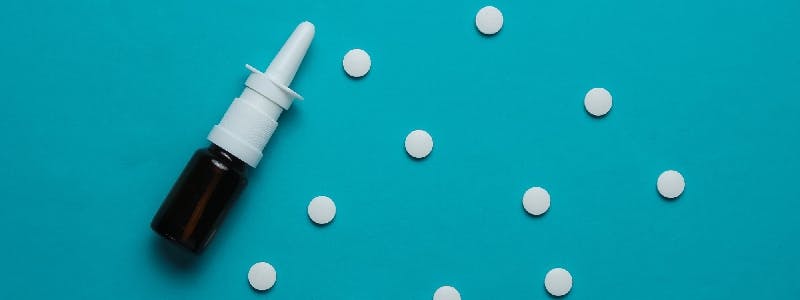
The Effectiveness of Fluticasone vs. Cetirizine
When allergy season hits hard, you’ll want to start having a trustworthy allergy medicine on hand to help fight off your symptoms. But with so many types of medications to choose from, how will you know what works best? While allergy medicines all have the same purpose, some products can work differently from others based on their active ingredients. You can find out what active ingredients are used for each brand by checking the label of a product.
There are several types of allergy medications that can be found on the shelves of your local pharmacy. Among these medications are fluticasone and cetirizine, which are two very different solutions for treating allergy symptoms. Read on to learn about the differences between fluticasone vs. cetirizine and how the two medications work.
What Are the Different Types of Allergy Medications?
Allergy medications can be taken as pills, liquids, inhalers, nasal sprays, eyedrops, skin creams and shots.1 Some medications require a prescription, while others can be purchased over the counter.1 How you choose to treat your symptoms will depend on your preferences. For instance, some people are bothered by the feeling of liquid running down their throats after using nasal sprays, and others may not feel like the ingredients in certain allergy pills work well for them.
The different types of allergy medicines are antihistamines, decongestants, corticosteroids, mast cell stabilizers and allergy immunotherapy.1 Antihistamines, decongestants, corticosteroids and mast cell stabilizers can be taken in a variety of forms. Immunotherapy is a way to gradually expose the body to allergens through a series of injections, allergen-based tablets and biological medications.1 This process helps to train the body not to react to certain allergens.1
What Is Fluticasone?
Fluticasone falls under the category of corticosteroids, which work by blocking the release of natural substances that cause allergy symptoms.2 Both prescription and nonprescription fluticasone comes as a liquid nasal spray that is used directly in the nose.2 Fluticasone nasal sprays are used to treat sneezing and a runny, stuffy, itchy nose that’s caused by hay fever or allergies to dust, pollen, mold or pet dander.2 Sneezing or stuffy nose that is caused by the common cold should not be treated with fluticasone nasal spray.2
How Should I Use Fluticasone?
Fluticasone nasal sprays are usually sprayed twice in each nostril daily for the first week of treatment. In the following weeks, you should spray once in each nostril daily.2 Your doctor may also recommend that you spray each nostril twice daily (morning and evening) at a lower dose.2 Fluticasone is only intended to be used in the nose. Do not administer the product orally, and make sure you do not spray the eyes or mouth.2 Avoid sharing your bottle of fluticasone spray with others, as this may cause germs to spread.2
What Is Cetirizine?
Unlike fluticasone, cetirizine is an antihistamine medication and works by blocking histamine, which is a substance in the body that causes allergic symptoms.3 Cetirizine is available as an oral medication in the form of a tablet, a chewable tablet, an extended release tablet or a syrup.3 It is used to temporarily relieve allergy symptoms, such as sneezing, runny nose and itchy eyes, nose or throat.3 Cetirizine can also be used to relieve itching and redness caused by hives, but it cannot be used to treat hives that are bruised or blistered.3 Some products combine cetirizine with pseudoephedrine to help with nasal congestion.3
How Should I Use Cetirizine?
Follow the directions on the package label or use as directed by a doctor.3 Drowsiness may occur after taking cetirizine, so avoid driving a car or operating machinery after taking this medication.3 Avoid alcohol consumption after taking cetirizine as well, as it may add to the drowsiness.3
Do Fluticasone and Cetirizine Work Differently?
If nasal congestion bothers you the most, fluticasone nasal sprays are more helpful to use. Intranasal steroids like fluticasone are recommended for treating moderate to severe allergy symptoms, and single-ingredient antihistamines, like cetirizine, do not treat nasal congestion.4 However, fluticasone nasal sprays do not immediately treat allergy symptoms.5 Several days of regular use is required before the full benefits of the spray can be felt.5 If your symptoms do not improve, talk to your doctor about other treatment methods.5
Nonprescription Fluticasone Nasal Sprays to Try
If you’re looking for a fluticasone nasal spray that doesn’t require a prescription, try FLONASE Allergy Relief Nasal Spray. FLONASE Allergy Relief works to block six allergic substances and provides you with long lasting 24-hour allergy relief to help get you through your day symptom-free. You can also try FLONASE Sensimist to get relief from your worst allergy symptoms in a gentle mist you can barely feel.
By using a fluticasone nasal spray daily, you can get powerful relief from the most irritating allergy symptoms. Learn more about the difference between allergy pills vs. nasal sprays and how to get started with FLONASE products on the FLONASE page.
Source Citations:
- Allergy medications: Know your options. Mayo Clinic. https://www.mayoclinic.org/diseases-conditions/allergies/in-depth/allergy-medications/art-20047403 Accessed 7/14/2022.
- Fluticasone Nasal Spray. MedlinePlus. https://medlineplus.gov/druginfo/meds/a695002.html Accessed 7/14/2022.
- Cetirizine. MedlinePlus. https://medlineplus.gov/druginfo/meds/a698026.html Accessed 7/14/2022.
- Guidelines on Antihistamines, Intranasal Steroids sprays and drops (Nasules). Berkshire West Integrated Care System and NHS. https://www.berkshirewestccg.nhs.uk/media/2330/apc-clindoc-025-guidelines-on-antihistamines-intranasal-steroid-sprays-and-drops-nasules.pdf Accessed 7/14/2022.
- FLONASE (fluticasone propionate) nasal spray. U.S. Food and Drug Administration. https://www.accessdata.fda.gov/drugsatfda_docs/label/2019/020121s045lbl.pdf Accessed 7/14/2022.